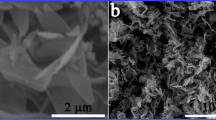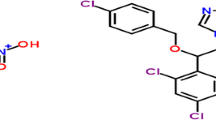Abstract
Screen printing is a promising technology because of its simplicity, low-cost, high reproducibility, and efficiency in large-scale production. In this work, a cobalt-based phosphate sensor was successfully fabricated using the screen printing technology for the determination of phosphate concentration in the aqueous solution. The disposable sensor consists of a fully integrated cobalt (Co) electrode, which is a layer of carbon conductive ink (C) physically doped with Co powder, and Ag/AgCl reference electrode. The SEM images show that the morphology of the Co electrode changes after exposure to the phosphate solution, indicating that the expendable reaction exists during the measurement. At the Co/C ratio of 1:99, the cobalt-based phosphate sensor shows phosphate-selective potential response in the range of 10−4 to 10−1 mol/L, yielding a detection limit of 1×10−5 mol/L and a slope of over 30 mV/decade in acidic solution (pH 4.5) for H2PO4 −. The proposed screen-printed sensor also exhibited significant reproducibility with a small repeated sensing deviation (i.e., relative standard deviation (R.S.D.) of 0.5%) on a single sensor and a small electrode-to-electrode deviation (i.e., R.S.D.<3.2%). The recovery study of H2PO4 − in real wastewater samples gave values from 95.4% to 101.8%, confirming its application potential in the measurement of phosphate in real samples. Apart from its high selectivity, sensitivity, and stability comparable with a conventional bulk Co-wire electrode, the proposed phosphate sensor still yields many other advantages, such as low price, compactness, ease of use, and the possibility of integration with other analytical devices such as flow injection analysis.
Similar content being viewed by others
References
Kwan RCH, Leung HF, Horn PYT, Cheung HCF. Amperometric biosensor for determining human salivary phosphate. Anal Biochem, 2005, 343: 263–267
Engblom SO. The phosphate sensor. Biosens Bioelectron, 1998, 13: 981–994
Xiao D, Yuan HY, Li J, Yu RQ. Surface-modified cobalt-based sensor as a phosphate-sensitive electrode. Anal Chem, 1995, 67: 288–291
Meruva RK, Meyerhoff ME. Mixed potential response mechanism of cobalt electrodes toward inorganic phosphate. Anal Chem, 1996, 68: 2022–2026
Engblom S O. Determination of inorganic phosphate in a soil extract using a cobalt electrode. Plant Soil, 1999, 206: 173–179
Chen Z, De Marco R, Alexander P W. Flow-injection potentiometric detection of phosphates using a metallic cobalt wire ion-selective electrode. Analyt Comm, 1997, 34: 93–95
De Marco R, Pejcic B, Chen Z. Flow injection potentiometric determination of phosphate in wastewaters and fertilisers using a cobalt wire ion-selective electrode. Analyst, 1998, 123: 1635–1640
Parra A, Ramon M, Alonso J, Lemos S G, Vieira E G, Nogueira R A. Flow injection potentiometric system for the simultaneous determination of inositol phosphates and phosphate: phosphorus nutritional evaluation on seeds and grains. J Agr Food Chem, 2005, 53: 7644–7648
Wang J J, Bishop P L. Development of a phosphate ion-selective microelectrode and its use in10 studies of the enhanced biological phosphorus removal (EBPR) process. Environ Technol, 2005, 26: 381–388
Zou Z, Han J, Jang A, Bishop PL, Ahn CH. A disposable on-chip phosphate sensor with planar cobalt microelectrodes on polymer substrate. Biosens Bioelectron, 2007, 22: 1902–1907
Fanjul-Bolado P, Queipo P, Lamas-Ardisana P J, Costa-Garcia A. Manufacture and evaluation of carbon nanotube modified screen-printed electrodes as electrochemical tools. Talanta, 2007, 74: 427–433
Avramescu A, Andreescu S, Noguer T, Bala C, Andreescu D, Marty JL. Biosensors designed for environmental and food quality control based on screen-printed graphite electrodes with different configurations. Anal Bioanal Chem, 2002, 374: 25–32
Tymecki L, Glab S, Koncki R. Miniaturized, planar ion-selective electrodes fabricated by means of thick-film technology. Sensors-Basel, 2006, 6: 390–396
Albareda-Sirvent M, Merkoci A, Alegret S. Configurations used in the design of screen-printed enzymatic biosensors. A review. Sensor Actuat B-Chem, 2000, 69: 153–163
Shih Y, Zen JM, Kumar AS, Chen PY. Flow injection analysis of zinc pyrithione in hair care products on a cobalt phthalocyanine modified screen-printed carbon electrode. Talanta, 2004, 62: 912–917
Martinez NA, Messina GA, Bertolino FA, Salinas E, Raba J. Screen-printed enzymatic biosensor modified with carbon nanotube for the methimazole determination in pharmaceuticals formulations. Sensor Actuat B-Chem, 2008, 133: 256–262
China EPA. Analysis Methods for Water and Wastewater (in Chinese), 3rd ed. Beijing: Chinese Environmental Science Press, 1997
Gilbert L, Jenkins ATA, Browning S, Hart JP. Development of an amperometric assay for phosphate ions in urine based on a chemically modified screen-printed carbon electrode. Anal Biochem, 2009, 393: 242–247
Bai Y, Tong JH, Bian C, Yan GL, Deng BL, Zhang H, Xia SH. Micro cobalt electrodes for detection of total phosphorus in water. Micro Nano Lett, 2012, 7: 1176–1179
Lee WH, Seo Y, Bishop PL. Characteristics of a cobalt-based phosphate microelectrode for in situ monitoring of phosphate and its biological application. Sensor Actuat B-Chem, 2009, 137: 121–128
De Marco R, Phan C. Determination of phosphate in hydro-ponic nutrient solutions using flow injection potentiometry and a cobalt-wire phosphate ion-selective electrode. Talanta, 2003, 60: 1215–1221
Author information
Authors and Affiliations
Corresponding author
Rights and permissions
About this article
Cite this article
Song, L., Zhu, L., Liu, Y. et al. A disposable cobalt-based phosphate sensor based on screen printing technology. Sci. China Chem. 57, 1283–1290 (2014). https://doi.org/10.1007/s11426-014-5127-6
Received:
Accepted:
Published:
Issue Date:
DOI: https://doi.org/10.1007/s11426-014-5127-6




